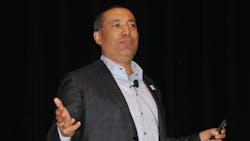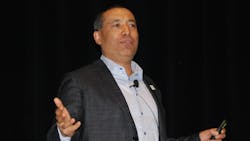Digitalization drives sustainability success
When it comes to sustainability there’s little doubt that technology is leading the way to meaningful progress toward net-zero goals. Digitalization, in particular, is a catalyst for corporations around the globe to answer many of the challenges that often hinder even the most well-meaning companies. That’s why many of the most successful companies on sustainability efforts have partnered with automation and other digital technology providers to create the kind of operational infrastructure needed to truly focus attention on decreasing emissions, increasing recycling capabilities and powering a different kind of industrial sector.
“In some ways it’s like we are creating a digital twin of planet earth,” said Andrea Ruotolo, global head of customer sustainability at Rockwell Automation.
Ruotolo is one of Rockwell Automation’s growing team of sustainability leaders focused on the acceleration and launch of new and enhanced customer sustainability offerings. This week at Automation Fair she moderated an Industry Forum panel featuring some of those customers, and they spoke to how they have found success in maneuvering the often confusing and difficult path to net-zero targets.
Given that ESG reporting is one of the main ways to show your sustainability bona fides to investors, customers and even potential workforce talent, having a solid data plan is essential to success. That’s where traceability, De Vriendt said, becomes an essential tool for sustainability.
“Traceability is the ability to follow a product through its entire value chain, not only internally inside a factory, but especially when a product leaves a factory,” he said. “The data can be aggregated on that product through its journey all the way to the end consumer and actually beyond that.”
He added that weaving a thread of structured and organized data around a digital identity serves many purposes, including better transparency, which can be the centerpiece for reporting on ESG goals. Data also serves a growing need consumer have for better transparency before they will be willing to pay for products. Therefore, solid data collection leads to premium brand identity, according to De Vriendt.
He also pointed to growing regulations where traceability can achieve more circularity and hold manufacturers accountable for their carbon footprint. Among those regulations are the EV Battery Passport, the EU’s Digital Product Passport and the Food Safety Modernization Act.
Renata Cardoso, vice president, sustainability and low carbon, Electra Battery Materials, agreed. Electra is building one of the first EV battery materials refineries outside of China, in Ontario. She said to be part of the EV industry, “You really have to position yourself in a way to avoid any sort of ESG complaints.”
She added that the company continues through its construction phase of its refinery, it’s used digital technology to enable it to build low-carbon operations from the start.
When polled about trends they were interested in to reduce their carbon footprint, the audience listed carbon capture, geothermal energy, wind power and hydrogen as their top choices. Green hydrogen has received a lot of momentum recently, especially following the Inflation Reduction Act of 2022 which allots investment dollars for U.S. development of the technology.
Green hydrogen is defined by hydrogen fuel that is produced from renewable sources such as wind turbines. In differs from blue hydrogen, which is derived from the extraction of natural gas. In either case, the primary use for hydrogen is as a transportation fuel.
“We want to displace diesel,” Sanjay Shrestha, chief strategy officer at Plug Power, told the audience. Plug is a U.S.-based company involved in the development of hydrogen fuel cells that can be used in buses and cars.
Plug has about 60,000 fuel subsystems operating in the field. Producing those large amounts of product means the need for automated operations. “I think automation is so important to what we’re doing because it allows for scalability,” he said.
That also helps keep costs in check. One of the biggest challenges cited by the audience in becoming more sustainable is the cost of products.
Likewise, automation helped HDG overcome it production challenges on its HFFS packaging machines for sustainability. The goal of German-based company is to use natural packaging material and shift away from plastics. Its operational objectives are to reduce machine electricity consumption and implement energy monitoring.
“We thought to ourselves, what can we do to reduce energy,” said Marcus Behrens, managing director for HDG.
He discussed the companies journey to a more transparent and automated process, which he credited to Rockwell Automation’s advice. “It’s not only for transparency of the process but also for predictive maintenance.”
For all of the panelists on the stage, digitalization and working in partnerships with automation suppliers proved to be the driving force behind their sustainable futures.
Get the best of Automation Fair 2022
When the event comes to a close, the best, most important coverage will be compiled into a report. Register now to pre-order the report and be among the first to receive it in your inbox.
About the Author

Leaders relevant to this article:


